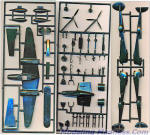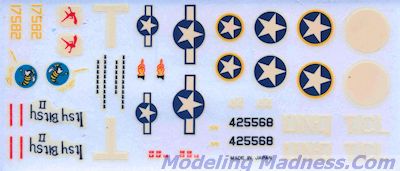Hasegawa 1/72 P-38 F/J/L Lightning
|
KIT #: |
D-14 |
|
PRICE: |
$16.98
|
|
DECALS: |
Three options |
|
REVIEWER: |
Peter Burstow |
|
NOTES: |
|

Well, there is plenty of history for the P-38
Lightning, much of it contradictory. The many reviews and previews on this site
are a good start. If you need more then a Google search will provide more than
anybody could read in a lifetime.
There are plenty of written
references out there as well.
 Coming
in a top opening box, there are three sprues with 48 parts in dark green
plastic. There are two styles of canopy, two types of landing lights, and a two
piece tail prop on a clear sprue. The parts are finely
moulded, with raised lines. There is flash on some of the parts, and a mould
joint line is visible. There are some ejector pin marks that mostly will be
hidden after construction.
Coming
in a top opening box, there are three sprues with 48 parts in dark green
plastic. There are two styles of canopy, two types of landing lights, and a two
piece tail prop on a clear sprue. The parts are finely
moulded, with raised lines. There is flash on some of the parts, and a mould
joint line is visible. There are some ejector pin marks that mostly will be
hidden after construction.
The cockpit comprises a floor,
seat, head-rest and a pilot figure. There is no sidewall detail, and no control
wheel. The nose gear bay is shallow and without detail. The main gear bays are
just open holes in the booms.
The variations are catered for
using the J model as the base. Rockets with trees are supplied for the L, and
alternate cowlings are supplied for the F model, with some surgery needed.
Alternate canopies are supplied, with the minor difference of an armoured
windscreen for the later versions. There is a wing leading edge landing light of
the F and early Js, and the inset light of the later models, with the holes
needing opening.
External stores are just the 10
rockets, and two drop tanks.
 The
instructions recommend 5 grams weight be added to prevent tail sitting, and a
tail prop is supplied for those who forget. The decal sheet has
markings for an European based 33rd squadron P-38J, an African based 94th
squadron P-38F with yellow bordered stars, both in OD over neutral grey, and a
Philippines based, headquarters squadron P-38L as flown by Major George Laven in
natural metal. Brightness was adjusted on the decal scan to show up the white
markings.
The
instructions recommend 5 grams weight be added to prevent tail sitting, and a
tail prop is supplied for those who forget. The decal sheet has
markings for an European based 33rd squadron P-38J, an African based 94th
squadron P-38F with yellow bordered stars, both in OD over neutral grey, and a
Philippines based, headquarters squadron P-38L as flown by Major George Laven in
natural metal. Brightness was adjusted on the decal scan to show up the white
markings.
The instructions are a folded sheet, clearly
printed on high quality paper. It shows 7 construction steps and a painting and
decaling guide. Alternate assemblies are shown for the different versions.
Paints are referenced by name only. There is a brief history in English.
The P-38 has been moulded by just
about all the major kit companies, and some of the minor ones as well. Judicious
reading of reviews and previews might help you decide which one is for you.
I could not find a copyright date on
the kit or instructions, but I'm guessing it was moulded in the late 1970's. It
has been re-released often in a variety of boxings with different decals.
There is a huge amount of aftermarket stuff
available, resin detail bits, etched brass, and many decal sheets.
A nice looking model kit, typical of
Hasegawa from that time. It lacks detail but that leaves room for a bit of
scratch building. Looks to be an easy build, with plenty of scope for
interesting paint jobs and customisation. Recommended for everybody.
Famous Fighters of the Second World War,
William Green, Macdonald, London, 1957.
War Planes of the Second World War, Fighters
Vol. 4, William Green, Macdonald, London 1961.
Lockheed P.38 Lightning A History, Anthony
Shennan, Historian, Campbelltown, 1970. This Australian monograph has the bonus
of a fold out 1/32 scale plan sheet, a colour cutaway view, and many detailed
photos including interiors.
P-38 Lightning In Action, Gene B Stafford,
Squadron/Signal, Carrollton, 1976.
Peter
Burstow
October 2014
Kit courtesy of my stash.
If you would like your product reviewed fairly and
fairly quickly, please
contact
the editor or see other details in the
Note to
Contributors.
Back to the Main Page
Back to the Previews Index Page



